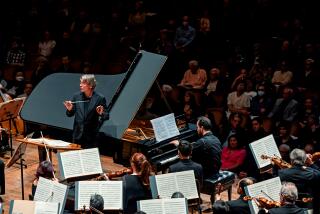MUSIC REVIEW : Pianist Pezzone Opens Recital Series at S.M. Museum of Art
- Share via
Since the days of Liszt, inventor of the solo recital, pianists have dreamed of presenting, in a series of concerts, a panorama of the piano literature. Many have actually done so. Over the weekend, at the unfinished but usable Santa Monica Museum of Art, Bryan Pezzone joined their number.
In five recitals, Friday through Sunday nights, the 26-year-old CalArts teacher surveyed keyboard expressions from Bach and Beethoven through Davidovsky and McGurty.
Additionally, Pezzone devoted one entire program to his own compositions, and included on others his improvisations. He played on a large and handsome Young Chang piano and on a Yamaha MIDI-grand, hooked up to electronic sound processing engineered by composer/sound designer Mark Waldrep. The pianist also utilized the assistance of flutist (and wife) Susan Pezzone and lighting designer John Kippen.
Friday, the opening program threatened to become a marathon all by itself through generous planning, a late start and the pianist’s talkativeness (“given as I am to verbosity,” he began one sentence). Yet the event had a sense of continuity and the length of the recital came out to be less than 130 minutes.
It began, after a spoken introduction, with Beethoven’s Sonata in E, Opus 109. Despite an impressionistic haze apparently characteristic of this particular Young Chang instrument, Pezzone nevertheless clarified all parts of the structure, provided acuteness in details and presented the work whole, and stylishly.
It ended with Waldrep’s “Colouri Spatialim,” for “MIDI Piano, sound modules and spatial locater,” a nine-minute exploration of two-note phrases and color variations that seemed in moments to turn the Yamaha into an electric organ.
In between there was, first, Pezzone’s “Elegy,” a 15-minute piece for flute and the electrified Yamaha in a pastel, pantonal idiom entirely the opposite of unpleasant.
Then, the pianist’s own solo “Improvisation (Theme and Variations)” in a similar but even more commercial style. This had the added interest--or distraction--of sonic color changes caused by the MIDI machine. As the composer promised, it grew loud, but not painful. Any discomfort it caused was purely aesthetic, resulting from an apparent lack of originality.
Before the program’s finale, Pezzone introduced to the public Mark McGurty’s Sonata for Piano, a work he has played in more specialized settings earlier this year.
Having heard the world premiere of McGurty’s Piano Concerto played by Pezzone and the Pacific Symphony two months ago, one needs to point out that McGurty utilizes different idioms in these two works.
The concerto purposefully--according to the composer and our own observation--inhabits a more accessible, neo-Romantic world. The sonata follows a spikier path, and speaks a more esoteric language. Both works sound important, as do other McGurty pieces (in symphonic, vocal and chamber mediums) we have heard only on tape.
The messages of the commanding Sonata for Piano are without doubt more visceral, more wrenching than intellectual or brain-titillating; its progress, clearly apprehendable by the ear, seems ineluctable. Like the Piano Concerto, it sounds the unmistakable ring of an individual, perhaps unique, voice.
More to Read
The biggest entertainment stories
Get our big stories about Hollywood, film, television, music, arts, culture and more right in your inbox as soon as they publish.
You may occasionally receive promotional content from the Los Angeles Times.










